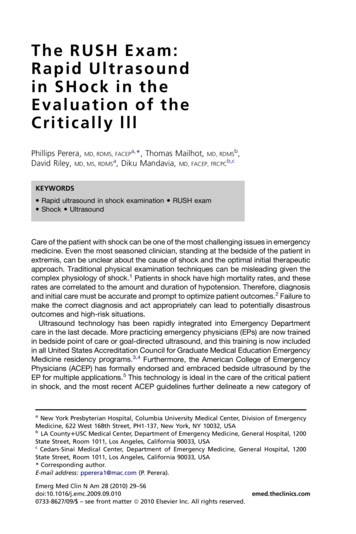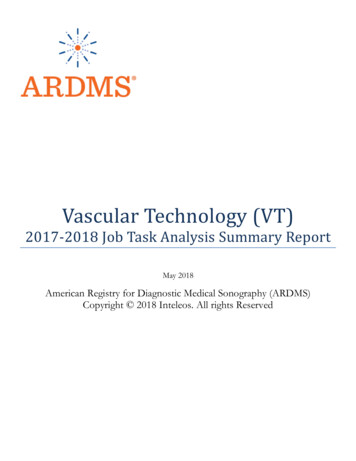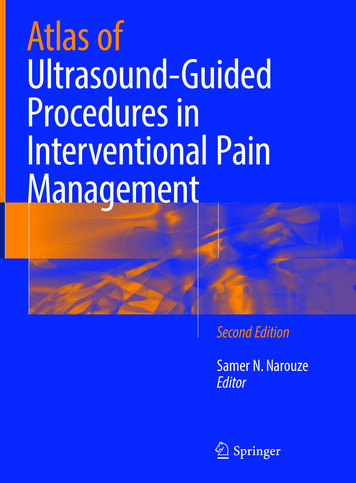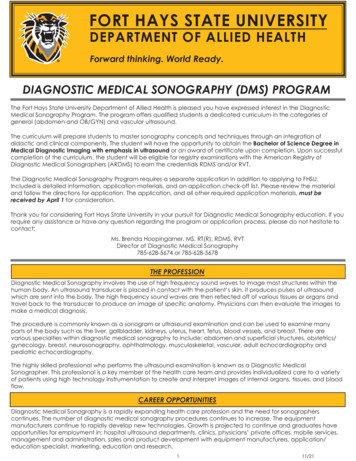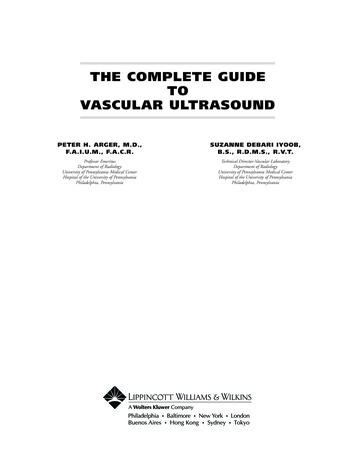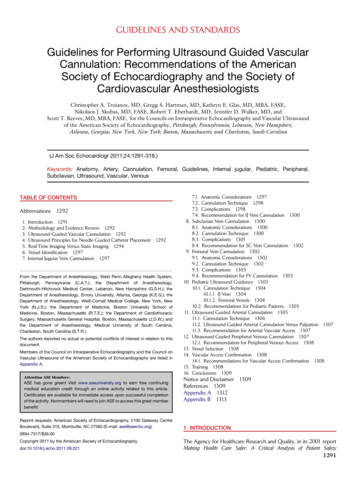
Transcription
GUIDELINES AND STANDARDSGuidelines for Performing Ultrasound Guided VascularCannulation: Recommendations of the AmericanSociety of Echocardiography and the Society ofCardiovascular AnesthesiologistsChristopher A. Troianos, MD, Gregg S. Hartman, MD, Kathryn E. Glas, MD, MBA, FASE,Nikolaos J. Skubas, MD, FASE, Robert T. Eberhardt, MD, Jennifer D. Walker, MD, andScott T. Reeves, MD, MBA, FASE, for the Councils on Intraoperative Echocardiography and Vascular Ultrasoundof the American Society of Echocardiography, Pittsburgh, Pennsylvania; Lebanon, New Hampshire;Atlanta, Georgia; New York, New York; Boston, Massachusetts; and Charleston, South Carolina(J Am Soc Echocardiogr 2011;24:1291-318.)Keywords: Anatomy, Artery, Cannulation, Femoral, Guidelines, Internal jugular, Pediatric, Peripheral,Subclavian, Ultrasound, Vascular, VenousTABLE OF n 1291Methodology and Evidence Review 1292Ultrasound-Guided Vascular Cannulation 1292Ultrasound Principles for Needle-Guided Catheter Placement 1292Real-Time Imaging Versus Static Imaging 1294Vessel Identification 1297Internal Jugular Vein Cannulation 1297From the Department of Anesthesiology, West Penn Allegheny Health System,Pittsburgh, Pennsylvania (C.A.T.); the Department of Anesthesiology,Dartmouth-Hitchcock Medical Center, Lebanon, New Hampshire (G.S.H.); theDepartment of Anesthesiology, Emory University, Atlanta, Georgia (K.E.G.); theDepartment of Anesthesiology, Weill-Cornell Medical College, New York, NewYork (N.J.S.); the Department of Medicine, Boston University School ofMedicine, Boston, Massachusetts (R.T.E.); the Department of CardiothoracicSurgery, Massachusetts General Hospital, Boston, Massachusetts (J.D.W.) andthe Department of Anesthesiology, Medical University of South Carolina,Charleston, South Carolina (S.T.R.).The authors reported no actual or potential conflicts of interest in relation to thisdocument.Members of the Council on Intraoperative Echocardiography and the Council onVascular Ultrasound of the American Society of Echocardiography are listed inAppendix A.Attention ASE Members:ASE has gone green! Visit www.aseuniversity.org to earn free continuingmedical education credit through an online activity related to this article.Certificates are available for immediate access upon successful completionof the activity. Nonmembers will need to join ASE to access this great memberbenefit!Reprint requests: American Society of Echocardiography, 2100 Gateway CentreBoulevard, Suite 310, Morrisville, NC 27560 (E-mail: ase@asecho.org).8.9.10.11.12.13.14.15.16.7.1. Anatomic Considerations 12977.2. Cannulation Technique 12987.3. Complications 12987.4. Recommendation for IJ Vein Cannulation 1300Subclavian Vein Cannulation 13008.1. Anatomic Considerations 13008.2. Cannulation Technique 13008.3. Complications 13018.4. Recommendation for SC Vein Cannulation 1302Femoral Vein Cannulation 13029.1. Anatomic Considerations 13029.2. Cannulation Technique 13029.3. Complications 13039.4. Recommendation for FV Cannulation 1303Pediatric Ultrasound Guidance 130310.1. Cannulation Technique 130410.1.1. IJ Vein 130410.1.2. Femoral Vessels 130410.2. Recommendations for Pediatric Patients 1305Ultrasound-Guided Arterial Cannulation 130511.1. Cannulation Technique 130611.2. Ultrasound-Guided Arterial Cannulation Versus Palpation 130711.3. Recommendation for Arterial Vascular Access 1307Ultrasound-Guided Peripheral Venous Cannulation 130712.1. Recommendation for Peripheral Venous Access 1308Vessel Selection 1308Vascular Access Confirmation 130814.1. Recommendations for Vascular Access Confirmation 1308Training 1308Conclusions 1309Notice and DisclaimerReferences 1309Appendix A 1312Appendix B 131313091. INTRODUCTION0894-7317/ 36.00Copyright 2011 by the American Society of Echocardiography.doi:10.1016/j.echo.2011.09.021The Agency for Healthcare Research and Quality, in its 2001 reportMaking Health Care Safer: A Critical Analysis of Patient Safety1291
1292 Troianos et alPractices, recommended the useof ultrasound for the placementASE American Society ofof all central venous cathetersEchocardiographyas one of its 11 practices aimedat improving patient care.1,2 TheCA Carotid arterypurpose of this document isCI Confidence intervaltoprovidecomprehensivepractice guidelines on the useFV Femoral veinof ultrasound for vascularIJ Internal jugularcannulation. Recommendationsare made for ultrasound-guidedLAX Long-axiscentral venous access of the inPICC Percutaneousternal jugular (IJ) vein, subclavianintravenous central(SC) vein, and femoral vein (FV)catheterizationon the basis of the strength of theSAX Short-axisscientific evidence present in theliterature (Table 1). The role ofSC Subclavianultrasound for vascular cannula3D Three-dimensionaltion of pediatric patients is discussed specifically, and the use2D Two-dimensionalof ultrasound to facilitate arterialcannulation and peripheral venous access is also discussed.Recommendations are made for training, including the role ofsimulation.Abbreviations2. METHODOLOGY AND EVIDENCE REVIEWThe writing committee conducted a comprehensive search of medical and scientific literature in the English language through the useof PubMed and MEDLINE. Original research studies relevant toultrasound-guided vascular access published in peer-reviewed scientific journals from 1990 to 2011 were reviewed using theMedical Subject Headings terms ‘‘ultrasonography,’’ ‘‘catheterization-central venous/adverse effects/methods,’’ ‘‘catheterization-peripheral,’’ ‘‘jugular veins,’’ ‘‘subclavian vein,’’ ‘‘femoral vein,’’‘‘artery,’’ ‘‘adult,’’ ‘‘pediatric,’’ ‘‘randomized controlled trials,’’ and‘‘meta-analysis.’’ The committee reviewed the scientific evidencefor the strength of the recommendation (i.e., risk/benefit ratio) assupportive evidence (category A), suggestive evidence (categoryB), equivocal evidence (category C), or insufficient evidence (category D). The weight or ‘‘level’’ of evidence was assigned withineach category (Table 1). Recommendations for the use of ultrasound were based on supportive literature (category A) with a level1 weight of scientific evidence (multiple randomized controlled trials with the aggregated findings supported by meta-analysis). Thedocument was reviewed by 10 reviewers nominated by theAmerican Society of Echocardiography (ASE) and the Society ofCardiovascular Anesthesiologists and approved for publication bythe governing bodies of these organizations.Journal of the American Society of EchocardiographyDecember 2011Cannulation of veins and arteries is an important aspect of patientcare for the administration of fluids and medications and for monitoring purposes. The practice of using surface anatomy and palpation toidentify target vessels before cannulation attempts (‘‘landmark technique’’) is based on the presumed location of the vessel, the identification of surface or skin anatomic landmarks, and blind insertion ofthe needle until blood is aspirated. Confirmation of successful cannulation of the intended vascular structure relies on blood aspiration ofa certain character and color (i.e., the lack of pulsation and ‘‘dark’’color when cannulating a vein or pulsation and a ‘‘bright’’ red colorwhen cannulating an artery), pressure measurement with a fluid column or pressure transducer, or observation of the intraluminal pressure waveform on a monitor. Although vascular catheters arecommonly inserted over a wire or metal introducer, some cliniciansinitially cannulate the vessel with a small caliber (‘‘finder’’) needle before the insertion of a larger bore needle. This technique is most beneficial for nonultrasound techniques, because a smaller needle mayminimize the magnitude of an unintended injury to surroundingstructures. The vessel is then cannulated with a larger bore 16gauge or 18-gauge catheter, a guide wire is passed through it, anda larger catheter is inserted over the wire. The catheter–over–guidewire process is termed the Seldinger technique.3Although frequently performed and an inherent part of medicaltraining and practice, the insertion of vascular catheters is associatedwith complications. Depending on the site and patient population,landmark techniques for vascular cannulation are associated witha 60% to 95% success rate. A 2003 estimate cited the insertion of 5 million central venous catheters (in the IJ, SC, and FV) annuallyin the United States alone, with a mechanical complication rate of5% to 19%.4 These complications may occur more often with less experienced operators, challenging patient anatomy (obesity, cachexia,distorted, tortuous or thrombosed vascular anatomy, congenitalanomalies such as persistent left superior vena cava), compromisedprocedural settings (mechanical ventilation or emergency), and thepresence of comorbidity (coagulopathy, emphysema). Central venous catheter mechanical complications include arterial puncture, hematoma, hemothorax, pneumothorax, arterial-venous fistula, venousair embolism, nerve injury, thoracic duct injury (left side only), intraluminal dissection, and puncture of the aorta. The most commoncomplications of IJ vein cannulation are arterial puncture and hematoma. The most common complication of SC vein cannulation ispneumothorax.4 The incidence of mechanical complications increases sixfold when more than three attempts are made by thesame operator.4 The use of ultrasound imaging before or during vascular cannulation greatly improves first-pass success and reduces complications. Practice recommendations for the use of ultrasound forvascular cannulation have emerged from numerous specialties, governmental agencies such as the National Institute for Health andClinical Excellence5 and the Agency for Healthcare Research andQuality’s evidence report.23. ULTRASOUND-GUIDED VASCULAR CANNULATION4. ULTRASOUND PRINCIPLES FOR NEEDLE-GUIDEDCATHETER PLACEMENTUltrasonography was introduced into clinical practice in the early1970s and is currently used for a variety of clinical indications.Miniaturization and advancements in computer technology havemade ultrasound affordable, portable, and capable of highresolution imaging of both tissue and blood flow.Ultrasound modalities used for imaging vascular structures and surrounding anatomy include two-dimensional (2D) ultrasound,Doppler color flow, and spectral Doppler interrogation. The operatormust have an understanding of probe orientation, image display, thephysics of ultrasound, and mechanisms of image generation and
Journal of the American Society of EchocardiographyVolume 24 Number 12Troianos et al 1293Table 1 Categories of support from scientific evidenceCategory A: supportive literatureRandomized controlled trials report statistically significant (P .01) differences between clinical interventions for a specified clinical outcome.Level 1: The literature contains multiple randomized controlled trials, and the aggregated findings are supported by meta-analysis.Level 2: The literature contains multiple randomized controlled trials, but there is an insufficient number of studies to conduct a viablemeta-analysis for the purpose of these guidelines.Level 3: The literature contains a single randomized controlled trial.Category B: suggestive literatureInformation from observational studies permits inference of beneficial or harmful relationships among clinical interventions and clinical outcomes.Level 1: The literature contains observational comparisons (e.g., cohort and case-control research designs) of two or more clinical interventionsor conditions and indicates statistically significant differences between clinical interventions for a specified clinical outcome.Level 2: The literature contains noncomparative observational studies with associative (e.g., relative risk, correlation) or descriptive statistics.Level 3: The literature contains case reports.Category C: equivocal literatureThe literature cannot determine whether there are beneficial or harmful relationships among clinical interventions and clinical outcomes.Level 1: Meta-analysis did not find significant differences among groups or conditions.Level 2: There is an insufficient number of studies to conduct meta-analysis, and (1) randomized controlled trials have not found significantdifferences among groups or conditions, or (2) randomized controlled trials report inconsistent findings.Level 3: Observational studies report inconsistent findings or do not permit inference of beneficial or harmful relationships.Category D: insufficient evidence from literatureThe lack of scientific evidence in the literature is described by the following conditions:1. No identified studies address the specified relationships among interventions and outcomes.2. The available literature cannot be used to assess the relationships among clinical interventions and clinical outcomes. The literature eitherdoes not meet the criteria for content as defined in the ‘‘focus’’ of the guidelines or does not permit a clear interpretation of findingsbecause of methodologic concerns (e.g., confounding in study design or implementation).Source: American Society of Anesthesiologists and Society of Cardiovascular Anesthesiologists Task Force on Transesophageal Echocardiography. Practice guidelines for perioperative transesophageal echocardiography. An updated report by the American Society of Anesthesiologists andthe Society of Cardiovascular Anesthesiologists Task Force on Transesophageal Echocardiography. Anesthesiology 2010;112:1084–96.artifacts and be able to interpret 2D images of vascular lumens of interest and surrounding structures. The technique also requires the acquisition of the necessary hand-eye coordination to direct probe andneedle manipulation according to the image display. The supplemental use of color flow Doppler to confirm presence and direction ofblood flow requires an understanding of the mechanisms and limitations of Doppler color flow analysis and display. This skill set mustthen be paired with manual dexterity to perform the threedimensional (3D) task of placing a catheter into the target vessel whileusing and interpreting 2D images. Two-dimensional images commonly display either the short axis (SAX) or long axis (LAX) of thetarget vessel, each with its advantage or disadvantage in terms of directing the cannulating needle at the correct entry angle and depth.Three-dimensional ultrasound may circumvent the spatial limitationsof 2D imaging by providing simultaneous real-time SAX and LAXviews along with volume perspective without altering transducer location, allowing simultaneous views of neck anatomy in three orthogonal planes.6 Detailed knowledge of vascular anatomy in the region ofinterest is similarly vital to both achieving success and avoiding complications from cannulation of incorrect vessels.Ultrasound probes used for vascular access vary in size and shape.Probes with smaller footprints are preferred in pediatric patients.Higher frequency probes ( 7 MHz) are preferred over lower frequency probes ( 5 MHz) because they provide better resolution ofsuperficial structures in close proximity to the skin surface. The poorerpenetration of the high-frequency probes is not typically a hindrance,because most target vascular structures intended for cannulation are 8 to 10 cm from the skin surface.It is important to appreciate how probe orientation relates to theimage display. Conventions established by the ASE for performingtransthoracic imaging of the heart, and more recently epicardial imaging, established that the probe indicator and right side of the displayshould be oriented toward the patient’s left side or cephalad.7 In thesesettings, projected images correlate best with those visualized by thesonographer positioned on the patient’s left side and facing the patient’s right shoulder. In contrast, the operator’s position duringultrasound-guided vascular access varies according to the target vessel. For example, the operator is typically positioned superior to thepatient’s head and faces caudally during cannulation of the IJ vein.The left side of the screen displays structures toward the patient’sleft side (Figure 1). In contrast, during cannulation of the FVs, the operator is typically positioned inferiorly and faces cephalad, so that theleft side of the screen displays structures toward the patient’s right side(see section 9, ‘‘Femoral Vein Cannulation’’). For SC vein cannulation,the left and right sides of the screen display cephalad and caudadstructures, depending on laterality (right or left). The changing imageorientation is an important distinction from typical transthoracic, epicardial, or transesophageal imaging. For ultrasound-guided vascularaccess cannulation, the probe and screen display are best orientedto display the anatomic cross-section that would be visible from thesame vantage point. Therefore, screen left and right will not followstandard conventions but rather vary with site and needle insertionorientation. What is common for all vascular access sites is that it is essential for the operator to orient the probe so that structures beneaththe left aspect of the probe appear on the left side of the imagingscreen. Although probes usually have markings that distinguishesone particular side of the transducer, the operator must identify whichaspect of the screen corresponds to the marking on the probe. Thesemarkings may be obscure, and a recommended practice is to movethe probe toward one direction or another while observing the screen
1294 Troianos et alFigure 1 Right neck central vein cannulation. The ultrasoundprobe is held so that each side of the screen displays ipsilateralstructures. With the probe mark placed on the upper left cornerof the image, the displayed structures will move in the samedirection with the probe.or apply modest external surface pressure on one side of the transducer to demonstrate proper alignment of left-right probe orientationwith image display.The probe used ultimately depends on its availability, operatorexperience, ease of use, and patient characteristics (e.g., smaller patients benefit from smaller probes). Some probes allow the use ofa needle guide, which directs the needle into the imaging planeand defined depth as viewed on the display screen (Figure 2).Needle guides are not available from every ultrasound probe manufacturer, but a needle guide may be a useful feature for the beginner who has not yet developed the manual dexterity of using a 2Dimage display to perform a 3D task. One study that evaluatedultrasound-guided cannulation of the IJ vein with and withouta needle guide showed that its use significantly enhanced cannulation success after first (68.9%–80.9%, P .0054) and second(80.0%–93.1%, P .0001) needle passes.8 Cumulative cannulationsuccess after seven needle passes was 100%, regardless of technique. The needle guide specifically improved first-pass successamong more junior operators (65.6%–79.8%, P .0144), while arterial puncture averaged 4.2%, regardless of technique (P .05) oroperator (P .05). A limitation of the needle guide is that the needle trajectory is limited to orthogonal orientations from the SAXimaging plane. Although helpful in limiting lateral diversion ofthe needle path, sometimes oblique angulation of the needlepath may facilitate target vessel cannulation. In addition, theremay be considerable costs associated with the use of needle guides.Depending on the manufacturer, they may cost as little as severaldollars to 100 each. Importantly, although the needle guide facilitated prompt cannulation with ultrasound in the novice operator,it offered no additional protection against arterial puncture.8However, one in vitro simulation study has refuted these in vivoresults.9Arterial puncture during attempted venous cannulation with ultrasound generally occurs because of a misalignment between theneedle and imaging screen. It may also occur as a result ofa through-and-through puncture of the vein into a posteriorly positioned artery. The first scenario is due to improper direction of theneedle, while the latter occurs because of a lack of needle depth control. Needle depth control is also an important consideration becauseJournal of the American Society of EchocardiographyDecember 2011the anatomy may change as the needle is advanced deeper within thesite of vascular access. The ideal probe should have a guide that notonly directs the needle to the center of the probe but also directsthe needle at the appropriate angle beneath the probe (Figure 2).This type of guide compensates for the limitation of using 2D ultrasound to perform a 3D task of vascular access. The more experiencedoperator with a better understanding of these principles and bettermanual dexterity may find the needle guide cumbersome, choosinginstead the ‘‘maneuverability’’ of a freehand technique. Althoughthe routine use of a needle guide requires further study, novice operators are more likely to improve their first-pass success.Vascular structures can be imaged in SAX, LAX, or oblique orientation (Figures 3A, 3B, and 3C). The advantage of the SAX view is better visualization of surrounding structures and their relative positionsto the needle. There is usually an artery in close anatomic proximity tomost central veins. Identification of both vascular structures is paramount to avoid unintentional cannulation of the artery. In addition,it may be easier to direct the cannulating needle toward the target vessel and coincidentally away from surrounding structures when bothare clearly imaged simultaneously. The advantage of the LAX viewis better visualization of the needle throughout its course and depthof insertion, because more of the needle shaft and tip are imagedwithin the ultrasound image plane throughout its advancement,thereby avoiding insertion of the needle beyond the target vessel. Aprospective, randomized observational study of emergency medicineresidents evaluated whether the SAX or LAX ultrasound approach resulted in faster vascular access for novice ultrasound users.10 The SAXapproach yielded a faster cannulation time compared with the LAXapproach, and the novice operators perceived the SAX approach aseasier to use than the LAX approach. The operator’s hand-eye coordination skill in aligning the ultrasound probe and needle is probablythe most important variable influencing needle and target visibility.Imaging in the SAX view enables the simultaneous visualization ofthe needle shaft and adjacent structures, but this view does not imagethe entire needle pathway or provide an appreciation of insertiondepth. Although novice users may find ultrasound guidance easierto adopt using SAX imaging, ultrasound guidance with LAX imagingshould be promoted, because it enables visualization of the entireneedle and depth of insertion, thereby considering anatomic variations along the needle trajectory as the needle is advanced deeperwithin the site of vascular access. The oblique axis is another optionthat may allow better visualization of the needle shaft and tip and offers the safety of imaging surrounding structures in the same view,thus capitalizing on the strengths of both the SAX and LAX approaches.115. REAL-TIME IMAGING VERSUS STATIC IMAGINGUltrasound guidance for vascular access is most effective when usedin real time (during needle advancement) with a sterile technique thatincludes sterile gel and sterile probe covers. The needle is observed onthe image display and simultaneously directed toward the target vessel, away from surrounding structures, and advanced to an appropriate depth. Static ultrasound imaging uses ultrasound imaging toidentify the site of needle entry on the skin over the underlying vesseland offers the appeal of nonsterile imaging, which obviates the needfor sterile probe coverings, sterile ultrasound gels, and needle guides.If ultrasound is used to mark the skin for subsequent cannulationwithout real-time (dynamic) use, ultrasound becomes a vessel locator
Journal of the American Society of EchocardiographyVolume 24 Number 12Troianos et al 1295Figure 2 Various needle guides, used to direct the needle at the center of the probe (and image) and at an appropriate angle anddepth beneath the probe. IJV, IJ vein. From Troianos CA. Intraoperative monitoring. In: Troianos CA, ed. Anesthesia for the CardiacPatient. New York: Mosby; 2002.Figure 3 Two-dimensional imaging of the right IJ vein (IJV) and CA from the head of the patient over their right shoulder. (A) SAX, (B)LAX, (C) oblique axis. SAX imaging displays the lateral-right side of the patient on the right aspect of the display screen and the medialstructures on the left aspect of the display screen. LAX imaging displays the caudad structures on the right aspect of the displayscreen and cephalad structures on the left aspect of the display screen. If the transducer is rotated counterclockwise about 30-40degrees, oblique imaging displays more lateral-right caudad structures on the right aspect of the display screen, while moremedial-left cephalad structures are on the left aspect of the display screen.technique that enhances external landmarks rather than a techniquethat guides the needle into the vessel. Both static and real-timeultrasound-guided approaches are superior to a traditionallandmark-guided approach. Although the real-time ultrasoundguidance outperforms the static skin-marking ultrasound approach,complication rates are similar.12
1296 Troianos et alJournal of the American Society of EchocardiographyDecember 2011Figure 4 Vessel identification. Right IJ vein (top) and CA (bottom) in SAX and LAX orientation. Slight external pressure compressesthe oval-shaped vein but not the round-shaped artery.Figure 5 Vessel identification with color flow Doppler. Arterial flow is visible in systole only, irrespective of Nyquist limit. Venous flow isvisible in systole and diastole, but only if the Nyquist limit is sufficiently decreased.Venous puncture using real-time ultrasound was faster and required fewer needle passes among neonates and infants randomly assigned to real-time ultrasound-assisted IJ venous catheterizationversus ultrasound-guided skin marking.13 Fewer than three attemptswere made in 100% of patients in the real-time group, comparedwith 74% of patients in the skin-marking group (P .01). In this study,a hematoma and an arterial puncture occurred in one patient each inthe skin-marking group.13One operator can usually perform real-time ultrasound-guidedcannulation. The nondominant hand holds the ultrasound probewhile the dominant hand controls the needle. Successful cannulationof the vessel is confirmed by direct vision of the needle entering thevessel and with blood entering the attached syringe during aspiration.The probe is set aside on the sterile field, the syringe removed, and thewire is inserted through the needle. Further confirmation of successfulcannulation occurs with ultrasound visualization of the guide wire in
Journal of the American Society of EchocardiographyVolume 24 Number 12Troianos et al 1297Figure 6 Vessel identification with pulsed-wave Doppler will distinguish artery (A) from vein (B) at a Nyquist limit of 650 cm/sec. Arterial blood flow has a predominately systolic component and higher velocity (A) compared with venous blood flow (B,C), which hassystolic and diastolic components and much lower velocity, better delineated with a lower Nyquist scale (69 cm/sec) (C).Figure 7 Variable overlap between CA and IJ vein. RIJV, Right IJvein. Adapted from J Vasc Interv Radiol.24the vessel. Difficult catheterization may benefit from a second personwith sterile gloves and gown assisting the primary operator by eitherholding the transducer or passing the guide wire.6. VESSEL IDENTIFICATIONMorphologic and anatomic characteristics can be used to distinguisha vein from an artery with 2D ultrasound. For example, the IJ vein hasan elliptical shape and is larger and more collapsible with modest external surface pressure than the carotid artery (CA), which hasrounder shape, thicker wall, and smaller diameter (Figure 4). The IJvein diameter varies depending on the position and fluid status ofthe patient. Patients should be placed in Trendelenburg position to increase the diameter of the jugular veins14,15 and reduce the risk for airembolism when cannulating the SC vein, unless this maneuver iscontraindicated. A Valsalva maneuver will further augment theirdiameter15 and is particularly useful in hypovolemic patients.Adding Doppler, if available, can further distinguish whether the vessel is a vein or an artery. Color flow Doppler demonstrates pulsatileblood flow in an artery in either SAX or LAX orientation. A lowerNyquist scale is typically required to image lower velocity venousblood flows. At these reduced settings, venous blood flow is uniformin color and present during systole and diastole with laminar flow,whereas arterial blood flow will alias and be detected predominantlyduring systole (Figure 5) in patients with unidirectional arterial flow(absence of aortic regurgitation). A small pulsed-wave Doppler sample volume within the vessel lumen displays a characteristic systolicflow within an artery, while at the same velocity range displays biphasic systolic and diastolic flow and reduced velocity in a vein. Alower pulsed-wave Doppler velocity range makes this distinctionmore apparent (Figure 6).Misidentification of the vessel with ultrasound is a common causeof unintentional arterial cannulation. Knowledge of the relative anatomic positions of the artery and vein in the particular location selected for cannulation is essential and is discussed below in thespecific sections. Ultrasound images of veins and arteries have distinct characteristics. Veins are thin walled and compressible andmay have respiratory-related changes in diameter. In contrast, arteries are thicker walled, not readily compressed by exter
Subclavian, Ultrasound, Vascular, Venous TABLE OF CONTENTS Abbreviations 1292 1. Introduction 1291 2. Methodology and Evidence Review 1292 3. Ultrasound-Guided Vascular Cannulation 1292 4. Ultrasound Principles for Needle-Guided Catheter Placement 1292 5. Real-Time Imaging V
